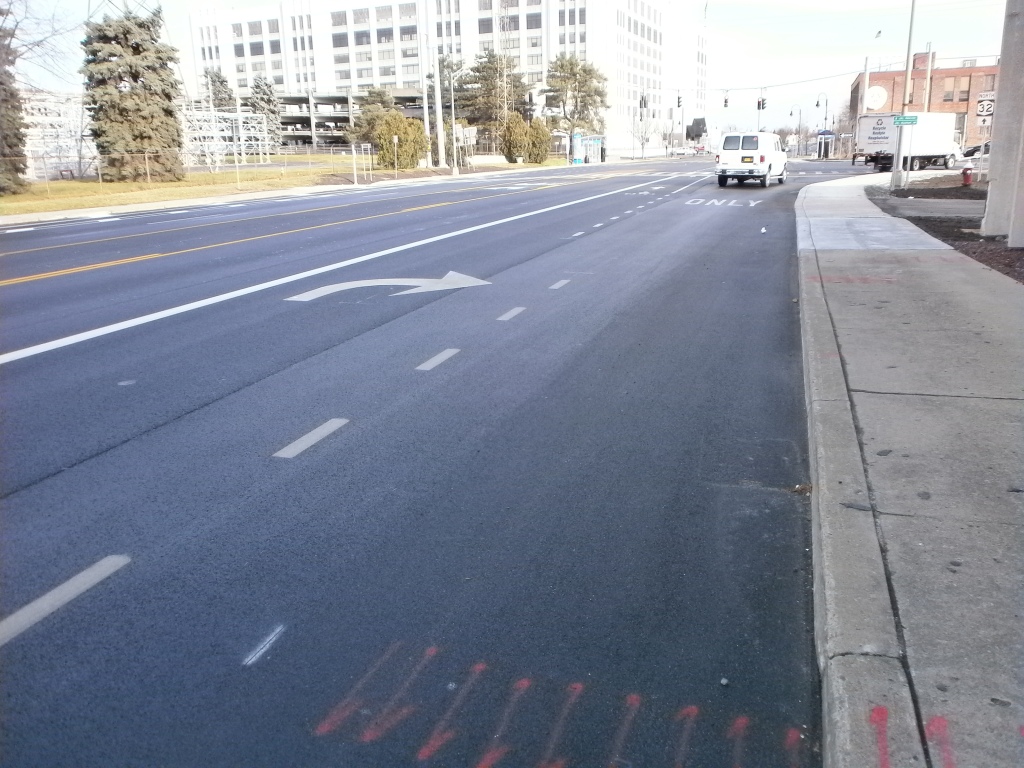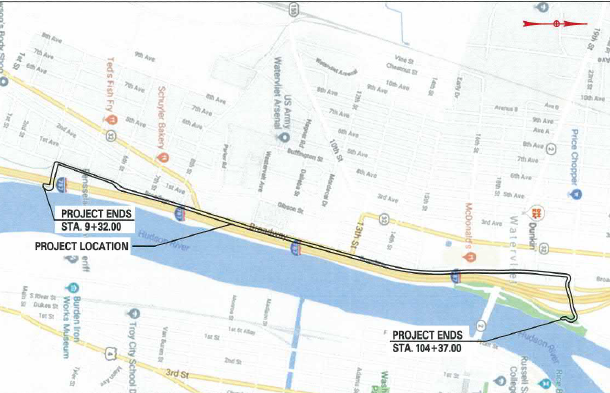Concerned Town of Colonie residents and cycling/walking advocates are pushing for a multi-use path from the British American Blvd. bike lanes at Rt 7/Troy-Schenectady Road, across River Road to the Mohawk-Hudson Bike-Hike Trail (MHBHT). This path would provide a safe connection for bicycles and pedestrians and avoid the hazardous current route along Route 7 and Rosendale Road. It’s the missing link in the CapitalNYBikeMap UAlbany-to-Lions-Park route (see map below); it’s a strategic component of the Capital District Trails Plan’s “Shaker Trail” (page 33); and it will link directly to Colonie’s extensive Ann Lee/Shaker trail system and the airport. For a detailed analysis of why this path is vital, read David Pratt’s letter below, following the map.
See also: Times Union 02-12-22 and Save Colonie’s campaign
The Ask – To support this project, please write to or email both the Town of Colonie supervisor and the planning director at:
The Honorable Peter Crummey, Supervisor
Town of Colonie
Colonie Memorial Town Hall
534 New Loudon Rd.
Latham, NY 12110-0508
Sean M. Maguire, Director
Planning and Economic Development
Public Operations Center
347 Old Niskayuna Road
Latham, NY 12110-2290
The UAlbany-to-Lions-Park route is a ten mile on- and off-road trail, providing a strategic north-south link across the I-90 / Central Ave. corridor. Commencing at Western Ave. / UAlbany, it eventually reaches the intersection of British American Blvd. and Route 7, as shown in blue on the map below. At that point the route becomes hazardous, as shown in red at the top. The proposed safe connection to MHBHT, under discussion, is shown in green.
Click the map to display it full-screen in a new tab.

Google directions: Western Ave.-UAlbany to Six Mile Waterworks
Google directions: Six Mile Waterworks to British American Blvd
David Pratt is a Town of Colonie resident and regular user of the trail. Mr. Pratt presented a statement at the Town of Colonie Planning Board Meeting on January 25, 2022 the text of which follows below.
++++++ DAVID PRATT LETTER TEXT ++++++
Dear Town of Colonie Planning Board,
My name is David Pratt. I would like to offer the following remarks. These remarks reflect my views only and not necessarily those of the multiple organizations that have signed the attached letter dated January 10, 2021.
I live on River Road approximately 1 mile east of the Northview Development. The Empire State Bike Trail (a.k.a. Colonie bike path, multi-use trail, Mohawk-Hudson Trail, Mohawk River hike & bike trail etc.) is 65 yards from our front door. Like hundreds of other town of Colonie residents, I love this bike path. I am grateful for it each and every time I go out for a run, bike ride or walk my dog. I also firmly believe it adds to the resale value of my property.
I share many of the concerns of my neighbors on Buhrmaster Rd., River Road, and in the Northview development who stand in opposition to this proposal by Keeler Motor Car Company. I agree that a road connecting Keeler motors to River Road would be dangerous and detrimental. This should not be part of the approved plan. River Road has already effectively become “alternate Route 7.” There is heavy traffic every rush hour on this rural and scenic road. There is also rampant speeding and littering that accompanies this overuse. So while I oppose a vehicular connection between the Keeler complex and River Road, a connecting bike and pedestrian trail is an entirely different matter and I think it is a great idea that, by itself, will not unduly harm my neighbors.
The purpose of my attendance here tonight is to submit into the public record a letter jointly created by several local public interest groups. We who have signed this letter believe that any approval of this Keeler Motorcar Company proposal should only be approved by this Planning Board if it includes the creation of a bike path similar to the one graciously proposed by Keeler in their initial proposal.
This Board must weigh the benefits and costs of any development of the Keeler property amongst all the stakeholders. The stakeholders include Keeler, Northview and River Road neighbors, and most importantly, the Town of Colonie citizens who this Board proudly represents. Reasonable compromise is required of all parties. I am confident that a satisfactory compromise will be worked out by this Board.
Any reasonable compromise for the Keeler expansion should include a connector bike/walking trail. My neighbors are correct to raise concerns about traffic, congestion, runoff, noise, and even light pollution. Their concerns should be addressed and ameliorated to the greatest extent possible. However, I part with my neighbors in their reported opposition to the bike/pedestrian connector trail that was part of the initial development proposal. The neighbors’ concerns do NOT preclude the creation of a bike path. Compromise is possible here. Unfortunately, the specific objection to the bike path proposal is a textbook example of the NIMBY (not in my backyard) response. It pits the objection of a very small group of neighbors against the overall benefit to a public group hundreds of times larger. Mr. Neidl’s 6/2/21 letter disparages what he called “various special interest groups” who for years have advocated for this bike-path connector. Indeed, many thoughtful planning committees over the years have advocated for this connecting trail. Their interest was the overriding public good that this linkage would contribute, not selfish “special interests.” In truth, the only “special interest group” being represented here tonight is Mr. Neldi’s clients who wish to block a safe bike trail connector. I urge this group to reconsider their opposition and work with us for a reasonable compromise.
This bike trail is needed to safely link the existing Mohawk River bike path to the existing British American Blvd./Watervliet Shaker Road bike path. This current path provides access to the Airport, Shaker Heritage Society, and Anne Lee Pond. Additionally, newly constructed bike and pedestrian lanes along Albany Shaker Road stretch this path all the way to the Desmond hotel, not terribly far from the Colonie Town Library and even The Crossings Town Park. It would be great to link these public assets together. Can someone please remind me of the exact millions of taxpayer dollars spent on the very pretty but under-used path bridge that crosses Watervliet Shaker Road near the airport? Should this path dead end on the treacherous Troy Schenectady Road as it does now? How many millions of dollars were spent on the exciting new Empire State bike trail that now safely connects Buffalo and Albany? The distance between these two trail networks is only several hundred yards. How does it not make perfect sense to have a safe connection between these two public assets? There is an obvious synergy to leveraging these two expensive projects together for the benefit of all users. Most of these users are constituents of this very Board that I stand in front of.
Peter Crummey is beginning his term as Town Supervisor. One of the most popular planks that he ran on was his promise of enhancing the town of Colonie’s parks and recreational opportunities. In his January 1st interview with WAMC, he made special reference to improving the town’s recreational facilities and parks along the Mohawk River. This bike path connector would do exactly that and would be a win for him and for everybody who enjoy these bike paths.
This connector would also benefit businesses along Troy Schenectady Road. I can personally attest to the huge increase I have seen in the numbers of people bicycling between Buffalo and Albany and beyond. I see them every day simply by looking out my front window. I myself made this journey with some three hundred other cyclists in July. This connector would allow users of the bike path to more easily and safely access hotels, restaurants, fast food, the airport, and often needed bike repairs at The High Adventure Ski and Bike shop. I would love the opportunity to be able to safely ride to a restaurant for dinner or lunch. My first visit would personally be Innovo Kitchen, but there’s lots of good competition!
This connector will also enhance bicycle commuting to all the businesses along British American Blvd and beyond. It is a painless way of furthering the “green initiative” ideals that increasingly drive public policy. It would also offer additional opportunities for healthy outdoor recreation that we have all come to appreciate in this COVID pandemic.
To capitalize on the huge growth in bicycle tourism, we need a safe connector between the Albany International Airport and the newly created Empire State bike trail. My neighbor and Shaker High School classmate, Steve Iachetta, also lives directly on the bike path, not 30 yards off of it. He also has noted the huge increase in bicycle tourism along this trail. He also happens to be a planner with the Albany Airport Authority. He told me he receives calls from air travelers traveling with touring bikes requesting directions and the pathway between Albany Airport and the Empire State Trail. I will quote him directly: “I regretted having to advise them “there is no safe connection and you need a car or bus to transport your touring bike from the airport to the nearby state trail system.” Touring the trail by bike is a national vacation destination … both you and I see that with the increasing number of touring bicycles on the path.”
The most important argument for this proposed bike path has to do with the personal safety of runners, walkers, cyclists, and dog walkers etc. who currently use these two respective un-linked trails. Again, these adults and children are some of the constituents of this Board. Right now, any connection between these two popular bike trails requires pedestrian or cycle access along the busy Troy-Schenectady Road. One must then bike, walk, or jog down one of three narrow, twisty, and hilly roads – Rosendale Rd., Buhrmaster Road, or Fort’s Ferry Road. One must then access the bike path along the river by crossing River Road at random and unmarked crossing locations. Can anyone argue that Route 7 or any of these three roads are safe for pedestrian or bicycle travel? Would you be comfortable with your children walking or bicycling on these roads? Any of us who drive these roads and attempt to safely pass cyclists and pedestrians are aware of the perils present on these roads that lead down the bike path. Yet the bike path is understandably a popular destination for runners, walkers, and pedestrians. And it will remain so. It is obvious that an off-road connector would be far safer and would enhance the quality of life for the capital District. Mr. Neidl’s 6/21/21 argument asserting that a bike path connector would be dangerous is clearly a spurious one.
I want to close on a very personal note. I am literally a lifelong resident of the Town of Colonie. I grew up in Loudonville. On Veterans Day in 1966, I was walking along Turner Lane in Loudonville with some other neighborhood children when my five-year-old brother was struck and killed by a car on the shoulder of Turner Lane. Now, decades later, I travel the Troy Schenectady Rd., River Road, Rosendale Road, Buhrmaster Road and especially Fort’s Ferry Road, multiple times each week and I dread coming upon another tragic accident. Over the intervening year’s countless children and adults have been killed or injured on our Town of Colonie roads. This proposed bike path would result in fewer pedestrians, runners, and bicyclists using these dangerous roads. It is very possible that a future life could even be saved by implementing this proposal. This alone is reason enough to create this short trail.
Sincerely,
David Pratt
++++++













































